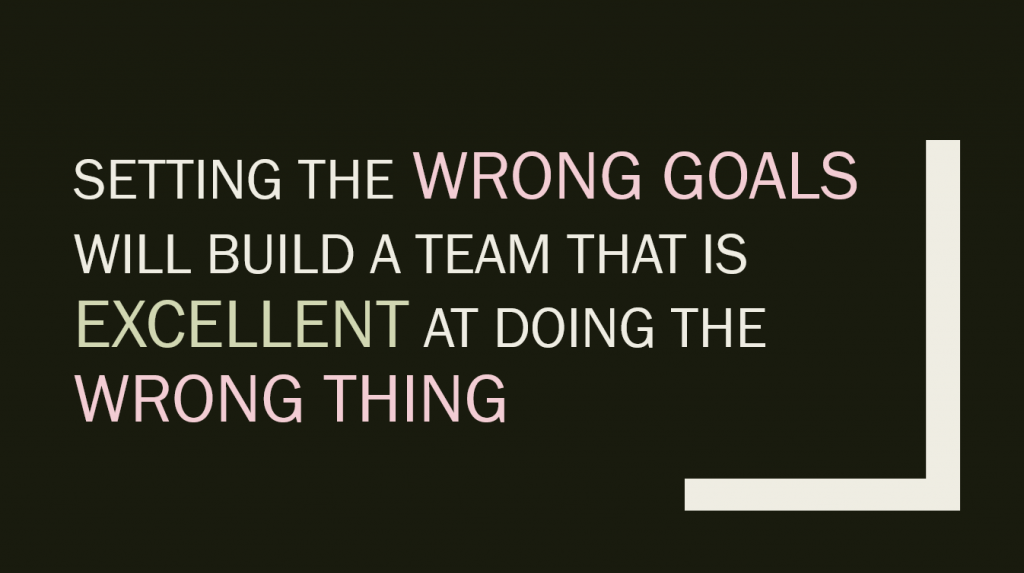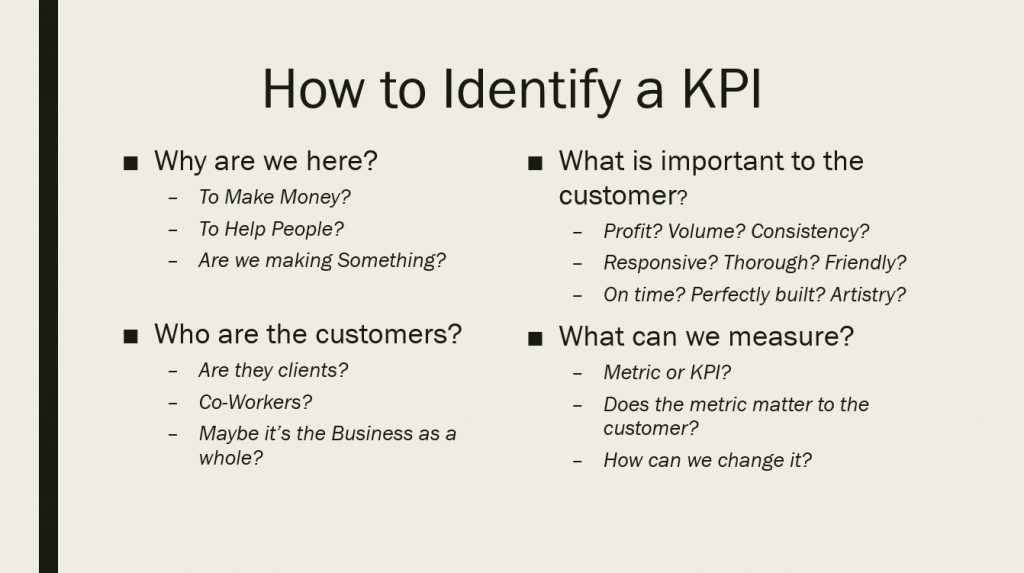Today’s managers have access to more data and analytical power than ever before. This 10-minute presentation was created to help business leaders of all kinds identify KPIs (Key Performance Indicators) in a sea of metrics and then use those KPIs to transform their buisness.
In this article, you will find both the slides and transcript.

Hello, Today we are going to talk about setting Goals.
Specifically, we will be looking at how to set the right goals. [And yes, there absolutely are right and wrong goals.]
To tell those two apart we will examine the difference between a metric and a KPI or Key Performance Indicator.

Before we talk about KPIs and metrics it’s important to simply understand a goal.
Merriam-Webster defines a goal as The end toward which effort is directed. https://www.merriam-webster.com/dictionary/goal
Often, especially in business, the act of setting a goal is viewed as inherently positive, but, when the wrong goal is selected, we focus our team in a direction that does not achieve success.
Setting the wrong Goals will build a team that is excellent at doing the wrong thing.

The first step to good goal setting is to define what makes you successful.
If you do not know what end you are working towards, chances are you aren’t going get there!
[alright, so]To identify success, we must start by asking a few question.
First, Why are we here? What is our product? And I don’t mean in a deep philosophical sense. Why are we employed, what is the purpose of our team?
- To make money?
- To help people?
- Maybe to make something?
All of these are relevant to different teams and groups. Your team may have multiple and that’s ok but take the time to ask your self the question think through the answer.
[Alright, second]Who do we support? Who are working for. Who do we interact with, and where does our product go? We might deliver reports to other departments or support our company’s clients.
From secretaries to VPs, Engineers to sales reps, very one working in a business has a customer. Most of us have multiple customers. Make a note of all of them, as you move to the next question….
[Probably the most important question…]What is important to the customer? Simply put: What makes your product good!
This answer will change depending on your customer, and every customer may have more then one answer.
If you’re in sales, you customer is a potential client, and your product to them is a solution to some problem or need that they have.
- That solution must be in budget, it has to work, and it has to be delivered on time.
In the same line of thinking that sales rep’s customer is also the Business as whole, and their product to the business is new customers
- The business might value a sales rep that signs the most customers, or a sales rep that signs the most profitable deals. Some Businesses want to know that sales reps are closing more deals than they lose.
All of these concerns are valid and knowing which one your customers value is key!
This is not just sales, if your doing customer support, you know some customer want the fastest possible interaction, while others prize thoroughness and having to call back is the worst case senecio.
If you’re creating something, from a report to a car, you have to look at each of your customers and evaluate what makes that product valuable from their perspective.
Answering these questions is not always going to be easy at first, but this is a mental exercise that will improve with practice.
[The final question that we have to ask, after we have answered all of these questions, is] What can we measure?What metrics are available? This questions requires us to switch from the conceptual questions we have already covered, to the hard capabilities of the systems and tools we work inside of.
Can you measure call time, Opportunity closure rate, production defect percentage?
With modern tools and systems there are probably hundreds of metrics available to you.
The trick is understanding which ones to dismiss, what to simply reference, and what is critical to your business. Experts from CFO magazine warn that using too many metrics can cripple your business, so be cautious when selecting your KPI’s and make sure you focus on what matters. (Van Caeneghem & Bequevort, 2016)
The right KPIs will drive your customer’s perception of success and [and this is very important] must be impacted by actions your team takes. [Which takes us to your next point..]

With our, KPIs Identified it is time to talk about Goal setting.
Success at this point should be a result, that is critically impactful for your business. That result can be measured by tracking your KPI!
A great KPI will strengthen employee Moral, Influence Business Objectives, and foster personal growth. (Poleski, P. 2019) Strive to accomplish all of those objects with every KPI you Identify.
Its time to pull it all together:
- First look at one way that we can be successful: If we are doing technical support and our customers [the company’s clients] value quick interactions and do not want to have to call twice.
- Then Find your KPIs and set a goal: Of all the metrics you can track in your various systems, the two most valuable may be: Average call time and Repeated call percentage. Your goal should be measurable, for example, an average call time under 10 minutes and a repeat call percentage under 5 percent.
- Make a plan based on actions: Simply telling your team to decrease their call time and fix every problem on the first call, does not work. Those are not actions your team can take. Once you know what your driving towards and how you’re going to track success, you must Identify actions that your team can take, typically changes to their process that will impact those KPI’s.
- This is not easy either, but it is where your skill as a seasoned leader will really shine. You, with a deep understanding of your business, may set the following goals to decrease the call time for your team:
- Always restate the customer’s concern before starting to troubleshoot: This step, may seem like it will take longer, but anyone who has done time in a call center knows this action is key to avoid time-draining misunderstandings.
- To ensure issues are resolved, you may have your team recreate the problem to verify the issue is resolved before disconnecting.
- Quality and Accountability: KPIs alone do not drive results, they need people ownership and accountability. (Chisambara, 2016) Your plan needs to include some method to ensure your team is taking the actions you identified. Good Action plans hold team members accountable to follow a plan, not the KPI itself.
- It works like this:
- If your team followed the action plan you’re provided, and the KPIs improved: It Worked! You picked the right actions, and your team followed through, The customer wins!
- If your team followed the action plan, but the KPI’s didn’t improve: well… you may have picked the wrong actions. Don’t get upset, it happens. Don’t throw away your work, simply pick a new set of actions and move on.
- If your team did not follow the action, no matter what the KPIs did: you need to sit down with your team and figure out why.
- This method of accountability shifts the responsibility of changing a seemingly uncontrollable number, like call back percentage, from your team to you, and in doing so gives them something very simple that they are responsible for.
- There are volumes that could be said about how to get buy-in, ability vs willing-ness, and effective coaching, and I encourage you to peruse those topics as well, but they do not fit into today’s presentation.
- Results: Give your plan time to work. Results in the form of KPI changes are rarely instant and require patience. Changing your team’s action every few days or even every few weeks will oftentimes do more damage than good as the results you’re looking for have not had enough time to show up in your reports.
Remember: The process of setting goals, making plans, and examining the outcome is circular, but once your KPIs are identified, they will rarely change.

[alright] Today we discussed how to identify KPIs and then how to use them to set effective goals.
I encourage all of you to put this practice to use and review your own teams to determine if you’re using the best Metrics to drive success in your organization.
Thank you for your time and have a wonderful day.
References
Chisambara, P. (2017) Why KPIs Alone Do Not Drive Results, Retrieved March 10, 2020, from https://erpminsights.com/why-kpis-alone-do-not-drive-results/
Goal [Def. 1]. (n.d.). In Merriam Webster Online, Retrieved March 10, 2020, from http://www.merriam-webster.com/dictionary/goal
Poleski, P. (2019) Why are key performance indicators important? Retrieved May 1, 2020 from https://www.klipfolio.com/blog/kpi-importance
Van Caeneghem, A. and Bequevort, J. (2016) How An Obsession with Metrics Is Killing Your Company, Retrieved April 29, 2020 from https://www.cfo.com/analytics/2016/04/obsession-metrics-killing-company/